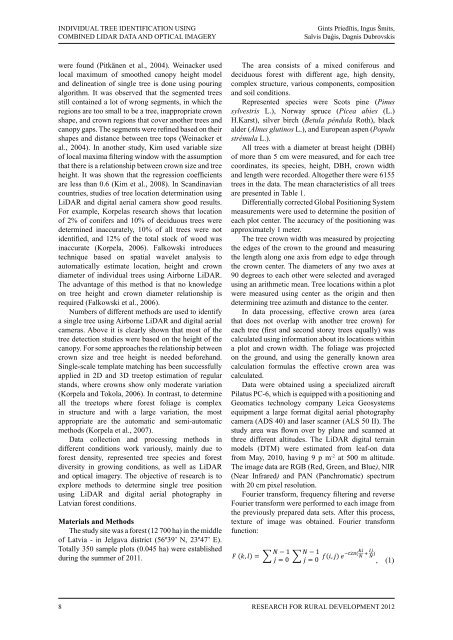RESEARCH FOR
RESEARCH FOR
RESEARCH FOR
You also want an ePaper? Increase the reach of your titles
YUMPU automatically turns print PDFs into web optimized ePapers that Google loves.
INDIVIDUAL TREE IDENTIFICATION USING<br />
COMBINED LIDAR DATA AND OPTICAL IMAGERY<br />
were found (Pitkänen et al., 2004). Weinacker used<br />
local maximum of smoothed canopy height model<br />
and delineation of single tree is done using pouring<br />
algorithm. It was observed that the segmented trees<br />
still contained a lot of wrong segments, in which the<br />
regions are too small to be a tree, inappropriate crown<br />
shape, and crown regions that cover another trees and<br />
canopy gaps. The segments were refined based on their<br />
shapes and distance between tree tops (Weinacker et<br />
al., 2004). In another study, Kim used variable size<br />
of local maxima filtering window with the assumption<br />
that there is a relationship between crown size and tree<br />
height. It was shown that the regression coefficients<br />
are less than 0.6 (Kim et al., 2008). In Scandinavian<br />
countries, studies of tree location determination using<br />
LiDAR and digital aerial camera show good results.<br />
For example, Korpelas research shows that location<br />
of 2% of conifers and 10% of deciduous trees were<br />
determined inaccurately, 10% of all trees were not<br />
identified, and 12% of the total stock of wood was<br />
inaccurate (Korpela, 2006). Falkowski introduces<br />
technique based on spatial wavelet analysis to<br />
automatically estimate location, height and crown<br />
diameter of individual trees using Airborne LiDAR.<br />
The advantage of this method is that no knowledge<br />
on tree height and crown diameter relationship is<br />
required (Falkowski et al., 2006).<br />
Numbers of different methods are used to identify<br />
a single tree using Airborne LiDAR and digital aerial<br />
cameras. Above it is clearly shown that most of the<br />
tree detection studies were based on the height of the<br />
canopy. For some approaches the relationship between<br />
crown size and tree height is needed beforehand.<br />
Single-scale template matching has been successfully<br />
applied in 2D and 3D treetop estimation of regular<br />
stands, where crowns show only moderate variation<br />
(Korpela and Tokola, 2006). In contrast, to determine<br />
all the treetops where forest foliage is complex<br />
in structure and with a large variation, the most<br />
appropriate are the automatic and semi-automatic<br />
methods (Korpela et al., 2007).<br />
Data collection and processing methods in<br />
different conditions work variously, mainly due to<br />
forest density, represented tree species and forest<br />
diversity in growing conditions, as well as LiDAR<br />
and optical imagery. The objective of research is to<br />
explore methods to determine single tree position<br />
using LiDAR and digital aerial photography in<br />
Latvian forest conditions.<br />
materials and methods<br />
The study site was a forest (12 700 ha) in the middle<br />
of Latvia - in Jelgava district (56º39’ N, 23º47’ E).<br />
Totally 350 sample plots (0.045 ha) were established<br />
during the summer of 2011.<br />
Gints Priedītis, Ingus Šmits,<br />
Salvis Daģis, Dagnis Dubrovskis<br />
The area consists of a mixed coniferous and<br />
deciduous forest with different age, high density,<br />
complex structure, various components, composition<br />
and soil conditions.<br />
Represented species were Scots pine (Pinus<br />
sylvestris L.), Norway spruce (Picea abies (L.)<br />
H.Karst), silver birch (Betula péndula Roth), black<br />
alder (Alnus glutinos L.), and European aspen (Populu<br />
strémula L.).<br />
All trees with a diameter at breast height (DBH)<br />
of more than 5 cm were measured, and for each tree<br />
coordinates, its species, height, DBH, crown width<br />
and length were recorded. Altogether there were 6155<br />
trees in the data. The mean characteristics of all trees<br />
are presented in Table 1.<br />
Differentially corrected Global Positioning System<br />
measurements were used to determine the position of<br />
each plot center. The accuracy of the positioning was<br />
approximately 1 meter.<br />
The tree crown width was measured by projecting<br />
the edges of the crown to the ground and measuring<br />
the length along one axis from edge to edge through<br />
the crown center. The diameters of any two axes at<br />
90 degrees to each other were selected and averaged<br />
using an arithmetic mean. Tree locations within a plot<br />
were measured using center as the origin and then<br />
determining tree azimuth and distance to the center.<br />
In data processing, effective crown area (area<br />
that does not overlap with another tree crown) for<br />
each tree (first and second storey trees equally) was<br />
calculated using information about its locations within<br />
a plot and crown width. The foliage was projected<br />
on the ground, and using the generally known area<br />
calculation formulas the effective crown area was<br />
calculated.<br />
Data were obtained using a specialized aircraft<br />
Pilatus PC-6, which is equipped with a positioning and<br />
Geomatics technology company Leica Geosystems<br />
equipment a large format digital aerial photography<br />
camera (ADS 40) and laser scanner (ALS 50 II). The<br />
study area was flown over by plane and scanned at<br />
three different altitudes. The LiDAR digital terrain<br />
models (DTM) were estimated from leaf-on data<br />
from May, 2010, having 9 p m -2 at 500 m altitude.<br />
The image data are RGB (Red, Green, and Blue), NIR<br />
(Near Infrared) and PAN (Panchromatic) spectrum<br />
with 20 cm pixel resolution.<br />
Fourier transform, frequency filtering and reverse<br />
Fourier transform were performed to each image from<br />
the previously prepared data sets. After this process,<br />
texture of image was obtained. Fourier transform<br />
function:<br />
( ) ∑<br />
8 ReseaRch ( ) foR ( RuRal ) ( Development )<br />
2012<br />
∑<br />
(<br />
( )<br />
)<br />
, (1)


